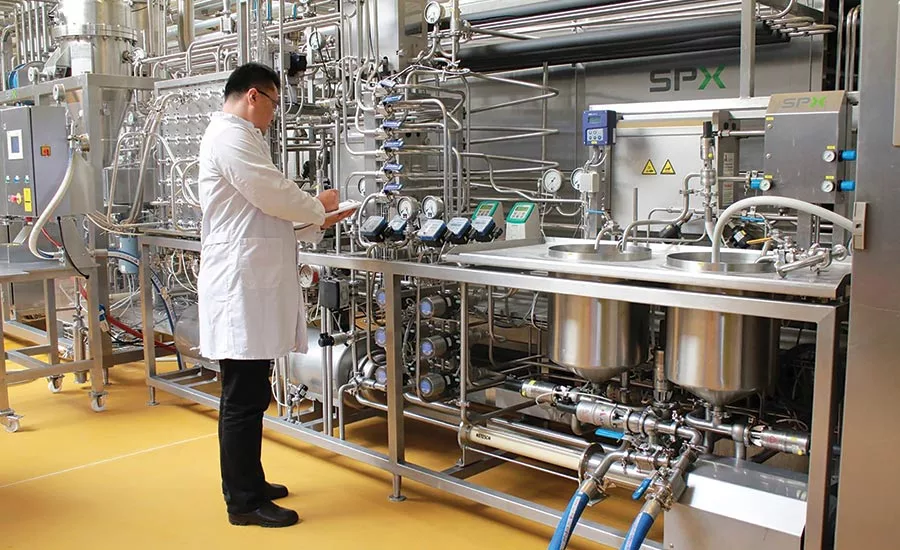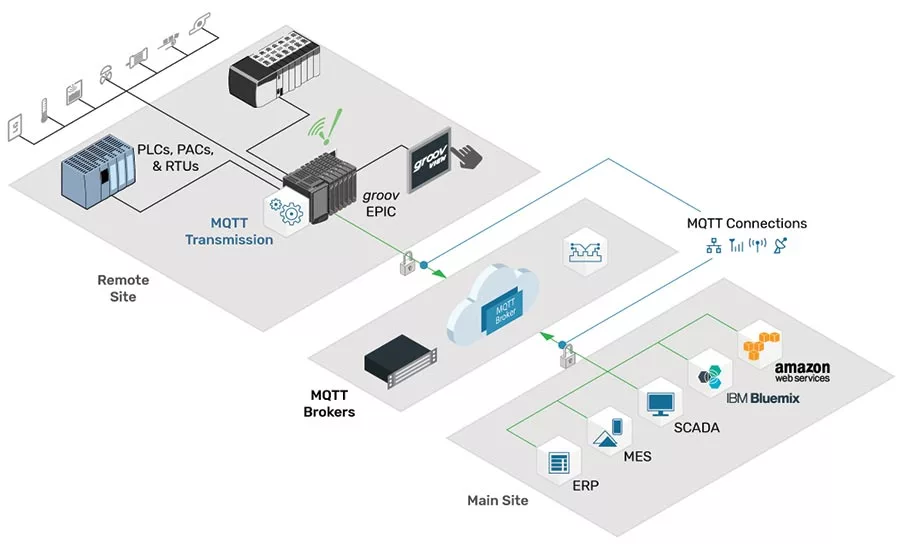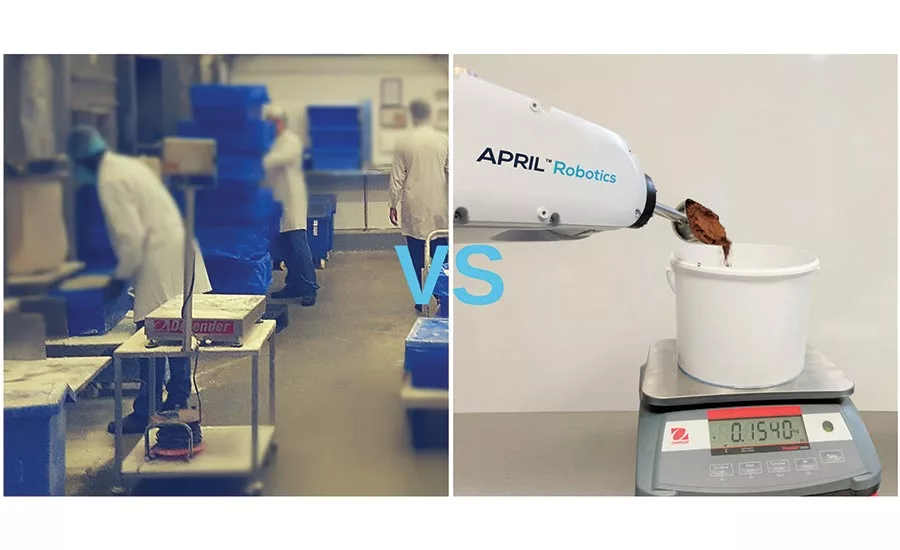Automation
Experts offer tips for picking an automation project and ensuring success

SPX FLOW says automation doesn’t have to involve buying numerous pricey PLCs, overhauling machines and adding complex communication infrastructures.
Photo courtesy of SPX FLOW

A modern controller like the groov EPIC from Opto 22 can help users justify an advanced automation project.
Image courtesy of Opto 22

OAL robots take over labor-intensive ingredient handling, saving money, reducing cross-contamination risk and cutting waste.
Photo courtesy of OAL

Many automation solutions exist for packaging and palletizing areas, but processing automation has been trickier to address. OAL’s APRIL Robotics Cooking Cell, or Robot Chef, automates batch cooking of soups, sauces and ready meals.
Photo courtesy of OAL
You have a processing or packaging line that could benefit from advanced automation updates. With overwhelming automation choices, how do you figure out if the project is worth spending $1 million to $2 million?
Engineering experts, system integrators and automation suppliers offer their insights to help you weigh numerous variables to decide which project is best. Among their top tips:
- Meet a goal or solve a problem with your project. In other words, don’t automate just for the sake of automating.
- Involve lots of people in the decision. From sales to human resources, everyone has a stake in the outcome.
- When projects compete, do your homework to find the one with the best value. The priority almost always is ROI, unless a processor is fixing a food safety or worker safety problem. Choose the top project after you analyze the contenders’ benefits for maintenance, production, product quality, etc.
Automation can help your plant increase throughput and efficiency; reduce machine footprints; use IIoT for flexibility to complete small seasonal runs or custom orders; and take full advantage of track and trace innovations.
But broadly speaking, collecting data is the reason for automation projects and connected operations. Data, “the most powerful tool in an engineer’s toolbox,” is what enables processors to make and sell their products faster and safer with more profits, says Jonathan Reed, global automation proposals and engineering manager, SPX FLOW Inc., a global supplier of process engineering and automation solutions to the dairy, food, beverage, pharmaceutical and healthcare sectors.
However, when people start to consider automation, they often envision “rack upon rack of expensive PLCs, complete machine redesigns or complex communication infrastructures,” says Reed.
But that’s not how it’s typically done.
“Automation doesn’t have to start off as a grand gesture,” he says. “Instead it can solve a more localized problem and then evolve to cater for wider and growing needs.”
He gives an example of automating CIP operations, instead of relying on operators to schedule each cleaning step. With manual CIP, the operators often start a step and move away to do other tasks. That step might finish several minutes before the operators can return to start the next one. An automated schedule cuts those lost minutes, so each step starts up right when the last one finishes.
What’s the true value?
Ben Rucker, director of process technology for CRB, cautions that manufacturers need to ensure before investing that they’ll truly get value from the additional information they gather. “Don’t get lost in the data,” he says. “Only collect the data you can manage.”
So much of evaluating whether to automate boils down to product safety, Rucker says. Automation is great for eliminating error and having repeatable measurements. “Automation allows manufacturers to remove the human element,” he says.
For example, if a facility automates bulk ingredient delivery, that upgrade could guarantee delivery at +/- 0.5%. The site would have batch records and could trace the ingredients throughout the process. “This level of documentation supports a product recall/product safety strategy,” he says. “Information from an automated program can be invaluable in one of those situations.”
Corporate vs. plant automation
Prasad Pai, partner and channel marketing director, resellers and distributors, GE Digital, points out that decisions to automate are made differently at the corporate level versus the plant level. “The biggest factor in deciding is always ROI,” he says. “At a plant level, the shorter-term ROI takes precedence, while at a corporate level, even though shorter-term ROIs are important to keep the project going, getting the longer-term ROI is the end goal.”
Corporate automation projects often depend on a broad objective, such as launching a new product or reaching operational excellence goals across the enterprise, he says.
The process likely will be goal-centric, and companies evaluate:
- Importance of the plant/line to the goal
- Infrastructure and worker readiness for advanced automation
- Effort needed to automate and maintain that level of sophistication
- A project’s ability to solve a critical problem or contribute significantly to the overall goal
An individual plant usually automates to address a local issue, such as product quality, capacity utilization, operational safety or regulatory compliance, Pai says. Or plants sometimes want to achieve certain goals for sustainability or productivity, for example. When weighing automation, he says plant leaders ask whether the project:
- Is critical to the plant’s viability
- Requires corporate IT approval and integration with corporate systems
- Has benefits versus the overall cost
- Can be added to existing infrastructure
- Can come from the operating budget or requires capital expenditures
Whether you’re looking to add robotics, update equipment to adjust to worker shortages or try advanced operational automation beyond PLCs/HMIs, let’s look at some solutions for the common challenges and pitfalls that projects face.
Challenge: We’re not sure automating is the right thing to do right now.
Solution: Hixson Architecture & Engineering recommends that its Automation Engineering group clients start with a site audit. Hixson helps with everything from feasibility assessments to startup and commissioning for single machine upgrades to full packing line integration.
“One of the most important things that we suggest is to consider using levels of automation as a way to introduce technology into your operation.”
– Craig Cheevers
“Whether or not to automate is not just a black and white question,” says Craig Cheevers, senior project engineer, automation. “Instead, a whole host of factors must be examined—factors which are unique to your facility and operation.”
Hixson’s site audit considers utility capacity, land availability for possible expansion, potential payback, and workforce expertise level for sophisticated automated systems.
The firm uses the data for a Choosing By Advantages session with clients, employing a methodology to reach consensus decisions and anchor choices to relevant facts. Using the approach, companies tend to make stronger, more informed decisions about these major investments, Cheevers says.
“One of the most important things that we suggest is to consider using levels of automation as a way to introduce technology into your operation,” he adds. “For example, automating an entire line may or may not be practical. Instead, you could start by automating at an individual component level.”
Challenge: You’re worried about how much downtime an upgrade will require.
Solution: Early in the project, ensure that startup and commissioning time is built into the schedule, Cheevers says. “From the point when the project ends to when production begins, you need adequate time to get the line, including all personnel, up to speed. Production will not be 100% on day one,” he says.
Matt Scott, lead systems integrator for Malisko Engineering, a CSIA Certified Member that offers batch and continuous process control solutions, suggests establishing a timeframe for your project when equipment usage is low. “Allow time for careful planning of design, development and implementation,” he says.
Having a process control consultant come up with an installation plan early in a project can mitigate risk and minimize downtime, says Scott Young, senior consultant for MAVERICK Technologies, a Rockwell Automation company. “We have seen things you may not have considered or planned for,” he says
MAVERICK Technologies’ OpCon Advantage assessment takes a holistic approach. One director of engineering requested that MAVERICK determine what it would take to upgrade a control system in eight hours. The company came up with a plan to get it done, but it was different than what the plant engineer originally had in mind, Young says. “We had to change the way they saw the project.”
Joe Martin, packaging market manager for Beckhoff Automation, notes that plants sometimes can automate a single process or line without shutting down and replacing systems across the facility. Beckhoff helps companies use PC-based control solutions to integrate islands of automation with a larger connected architecture.
That brings us to our next common problem …
Challenge: We’re not sure whether automating our older machines is worth it. And the automation that our plant does have was added in pieces as
time and budgets allowed, and now the machines don’t communicate well.
Solution: Consider open, PC-based control technologies, which will always be scalable and compatible, Martin says. That could prevent the need for a complete “rip and replace,” he notes. Beckhoff offers everything from industrial PCs, automation software and IIoT solutions to EtherCAT I/O modules, motors and drives, and multitouch control panels.
Open, real-time technologies can communicate with legacy components and networks while enabling the use of leading-edge technology, including cloud computing, integrated vision systems and machine learning algorithms, Martin explains.
Legacy PLCs and fieldbuses regularly become outdated. “Although automating a line might save money in the short term, it could lead to greater expenses if done incorrectly and with inflexible technologies,” he says.
Automating older equipment can have a different approach than with a new line, notes Mike Psaltis, control systems engineer for Malisko. “Often, bringing older technology up to date can provide a controlled and preemptive way to keep equipment running and clean up years of changes that were never fully integrated,” he says.
Pai of GE Digital says poor communication among machines is a common problem that could be hurting productivity. “We have seen facilities that are 30-40 years old that have existing automation that is completely closed, or the plant floor has as many different Level 0/1 systems as there are lines,” he says.
Challenge: You’re not sure you have enough room or whether the project will be worth renovations or expansion.
Solution: The amount of physical change a plant needs will depend of the scope of the advanced automation project, Pai says. If you want to add cybersecurity on top of an existing automated plant floor, this could require changing the plant’s network infrastructure. Say you want to install cameras and vision systems on the lines. The plant may need new optic fiber networks for video streaming.
“The ROI or situational emergency sought and perceived from the advanced automation project determines how drastic the change has to be in an existing facility,” Pai explains.
At the same time, you might not need more space for some of the projects that Beckhoff helps with. Industrial PCs can do the job of multiple PLCs, motion controllers and other standalone devices, Martin says. EtherCAT, the Ethernet-based fieldbus system that Beckhoff developed, provides a switchless network, which saves additional space and costs, he says.
The technologies allow integration right on the machine, often eliminating unnecessary components to actually shrink the footprint. “So before plant managers start knocking down walls, they should explore new technologies that make it possible to utilize smaller machines that can do the work of multiple machines,” he says.
Challenge: You have many projects you’d like to do, and you’re not sure how to pick.
Solution: Stellar, an integrated design-build firm that helps with automation, encourages processors to use a checklist to ensure all impacts are analyzed with cost estimates. Organizations with experience in similar projects should use reference class estimating to avoid underestimating costs and overestimating benefits, says Michael Griffith, Stellar director of business analytics.
“When capital is limited and many projects compete, highest value projects must take the priority spot,” he says.
CRB, which provides programming and I&C teams to assist clients, often creates a simulation of manufacturers’ processes to evaluate options. That helps processors make data-driven decisions before investing, Rucker says. “Simulations can be incredibly powerful tools for processors deciding where and to what extent to automate their process,” he says.
OAL’s goal for its robotics for ingredient handling and batch cooking is to help manufacturers achieve payback on investments within two years.
The best way to do that is to remove operators to reduce labor costs, so the company starts with a review to find areas with manual tasks, says Jake Norman, head of innovation. “If you can automate this, the labor cost reduction will soon justify the capital investment upfront.”
Processors also should assign monetary values to the expected productivity increase and waste reduction. OAL typically requests up to a year of production data to fully understand processes and products and help define system requirements.
The company shares a full simulation of the finalized design in a virtual environment. Manufacturers see the system in action with their own ingredients and processes through a series of trials at a test facility.
Opto 22, which offers the groov EPIC controller to handle full plant automation, integration and data handling, uses pareto charts (with line and bar graphs) to help clients visualize which upgrade can provide the biggest improvement for the amount of effort and time, says Garrick Reichert, senior applications engineer. Ranking projects based on the quickest return is a good starting point, and often the most important metric for corporate management, he notes.
The most important reason to automate is to improve worker safety, he says. “Anytime you can automate a dangerous task, you should proceed.” The next important reason would be to increase line efficiency, which could be for less waste, more throughput and/or more uptime.
Challenge: Your small or medium-sized company is unsure it can handle an automation project without the team of engineers and technicians that big companies have.
Solution: Businesses without in-house controls and automation support often go with turnkey solutions from OEMs and integrators, Reichert says. They also tend to purchase support contracts and require machines to have remote connectivity. Some of that cost can be moved from capital to operating spending, he says, but usually the project will have to be smaller in scope to allow for those expenses.
This is one situation where Hixson’s idea of building automation in levels can be helpful. Smaller companies may not be able to implement automation as quickly as larger ones and may have to rely more on outside automation resources until they can build or add the skills internally, Cheevers says.
“Automation offers up a Catch-22: Automation can reduce the number of personnel required for companies to operate the systems, but if the automated system goes down, someone who knows how to bring it back online quickly is required.”
An important duty of any service provider is to help the customer understand how to support automation, says Scott of Malisko. “A fully managed network architecture may not be ideal for a plant that has no one familiar with networking.”
An integrator can provide in-depth training, and the customer must invest in continuous training for employees to move toward automation, he says. General support contracts are popular for continuous training and improvement.
Young of MAVERICK says smaller companies tend to have multiple redundant stations strategically located throughout the facility. That way, if one interface fails, others could serve as the backup until someone could take a spare one, preloaded with the program application, off the shelf and replace it, he says.
During training classes, participants are each given an “automation bible,” which consists of a complete set of P&IDs, electrical drawings, instrumentation documentation, to help them understand how to access and troubleshoot the new automation system, Young says.
As companies get more experienced and comfortable with automation, many tend to upgrade their systems with supervisory control and data acquisition (SCADA) operator interfaces; recipe-based production systems; and electronic regulatory, manufacturing execution system (MES) production and downtime reporting. Many also look to bring information from their automation systems to their enterprise resource planning (ERP) and warehousing systems.
MAVERICK Technologies offers PlantFloor24, a global operations center that supports the facility after commissioning with remote management and monitoring services.
Larger companies with more staff support may benefit from having a set of automation standards developed for them, Young says. They, too, would benefit from training on their automation and control system.
Don’t miss these overlooked factors
- Cybersecurity: When you network a system, you’re opening it to potential threats.
- Food safety plans: Your safety measures for legal compliance likely will need an update for your automation upgrades. For the construction phase, the plant should follow a HACCP plan with special requirements and conditions for the project, such cordoning off areas or requiring extra ventilation, says Reichert of Opto 22.
- Wiring costs: Many systems require many hardwired connections that can add significant cost, Reichert points out. Using modern automation systems with devices that can communicate over Ethernet can solve the problem, saving panel space.
- Stakeholder support: When Griffith of Stellar recommends getting input from a wide range of stakeholders, he wants you to think beyond the teams involved in production. Does human resources support the estimated reduction in staff? Do the sales projections for the coming years support the estimated project benefits? “I’ve seen automation projects completed only to learn the facility closed months later,” he says.
- Building codes: When you need to evaluate updated building codes, getting help from an engineering firm is a good idea. They’re required to keep up with code changes.
- Software costs: This can be an unexpected expense for companies that don’t have extensively automated facilities, says Cheevers of Hixson.
- Qualified electricians: The contractor must be qualified for automation work, which requires different skills than typical power and lighting jobs, Cheevers says.
- Complicated components: Ask how easily the system can be updated because small companies often don’t realize how many switches and routers are needed, says Robert Trask, Beckhoff senior systems architect. “Besides wasting thousands of dollars on each panel, the extraneous switches and routers provide no boost in performance—in fact, they hinder performance. With EtherCAT, the limitations of the traditional fieldbus are eliminated,” Trask says.
- The next five years: Think about how automation will change after your project, Trask says. EtherCAT is suited for future integration with time-sensitive networking (TSN) and gigabit communication.
Every food processing and packaging operation faces unique challenges that affect when and how to best introduce new automation technology, says Trask’s Beckhoff colleague Joe Martin. After the initial capital acquisition costs, upgrades completed with flexible technologies will provide a path to greater efficiency and ROI, he says. ”Generally speaking, if you can automate a process, you should.”
To learn more about innovations in food and beverage manufacturing, click here!
For more information:
Beckhoff Automation, www.beckhoffautomation.com
CRB, www.crbusa.com
GE Digital, www.ge.com/digital
Hixson Architecture & Engineering, www.hixson-inc.com
OAL, www.oalgroup.com/april-robotics
Opto 22, www.opto22.com
Malisko Engineering, www.malisko.com
MAVERICK Technologies, www.mavtechglobal.com
SPX FLOW, www.spxflow.com
Stellar, www.stellar.net
Looking for a reprint of this article?
From high-res PDFs to custom plaques, order your copy today!









